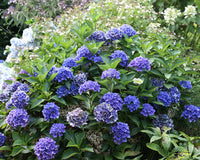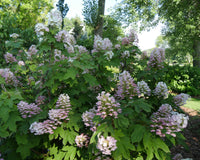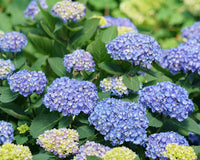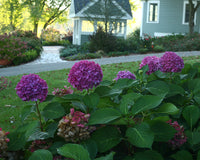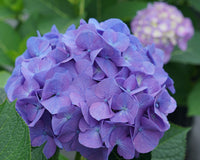The key to success in gardening is matching a plant's needs - water, light, soil type - with the actual conditions in your yard, and there's really no better example of how crucial that is than with big-leaf hydrangeas (Hydrangea macrophylla). Everyone, it seems, loves these colorful emblems of summer, but when it comes to actually growing them, not everyone has had a pleasant or positive experience. It's not that the people who have struggled just aren't good at gardening - that's ridiculous, since gardening is a constant process of learning and no one is born with plant knowledge - it's that they're doing the horticultural equivalent of trying to make a square peg fit in a round hole. Here are the basic do's - and do nots - of growing big-leaf hydrangeas successfully.
Do:
Plant in a spot with some sun.
For the most blooms and best color, a bit of sunlight daily is important. In hot climates (USDA zone 7 and warmer), full shade during the hottest part of the day is imperative, so sun should be only in the morning or late evening. In cooler climates (USDA zones 4-6), they can be planted in full sun all day. They may wilt a bit on very hot days, but as long as they are watered regularly, this doesn't indicate an issue.
Water often.
The foliage of all plants loses some water through the process of photosynthesis, which is totally normal. However, the large leaves on big-leaf hydrangeas give off a lot of water, so plants need to be compensated with irrigation or rainfall for best performance. Watering every day is probably too much in all but extreme cases; a thorough watering 1-3 times a week should be sufficient during flowering and periods of hot weather.
Mulch.
Big-leaf hydrangeas have shallow roots, which increases the risk of drying out and heat stress. A good 2-3" layer of shredded bark mulch conserves moisture and keeps the roots cool so they can grow more quickly, resulting in a healthier, happier plant. You can also opt for a mulch of pine straw or compost, but avoid rock mulches of all types - they retain a lot of heat so can have the opposite effect.

Don't:
Prune or cut back big-leaf hydrangeas.
This is probably the number one mistake people make with them, and it's no wonder: once the plant goes dormant in winter, it simply looks like it ought to be cut back. Resist the temptation! The flower buds for the following summer have already formed on the plant, and cutting it back will remove them.
Fertilize after late July.
Especially if you live in a colder climate, fertilizing your hydrangeas monthly beginning in early spring is a good idea. However, by late July, the plant is already receiving environmental cues that begin to trigger the dormancy process (crazy, right?!), and fertilizing after this point pushes soft new growth that increases the chance for winter damage. So cease fertilizing no later than the end of July; similarly, it's also a good idea to start tapering off supplemental irrigation at this point, as excess water can also push soft new growth. You can read more on fertilizing hydrangeas in this article.
Don't give up!
If you haven't yet achieved success with big-leaf hydrangeas, don't get discouraged - just try planting them in a different spot in your yard. Look for a spot on the east side of your home, near its walls. This siting provides some protection from the direction of the harshest winter weather, and typically provides afternoon shade as well. Big-leaf hydrangeas are pretty easy to transplant, thanks to those shallow roots, so try moving it in early spring and following the advice in this article to get back on track.



